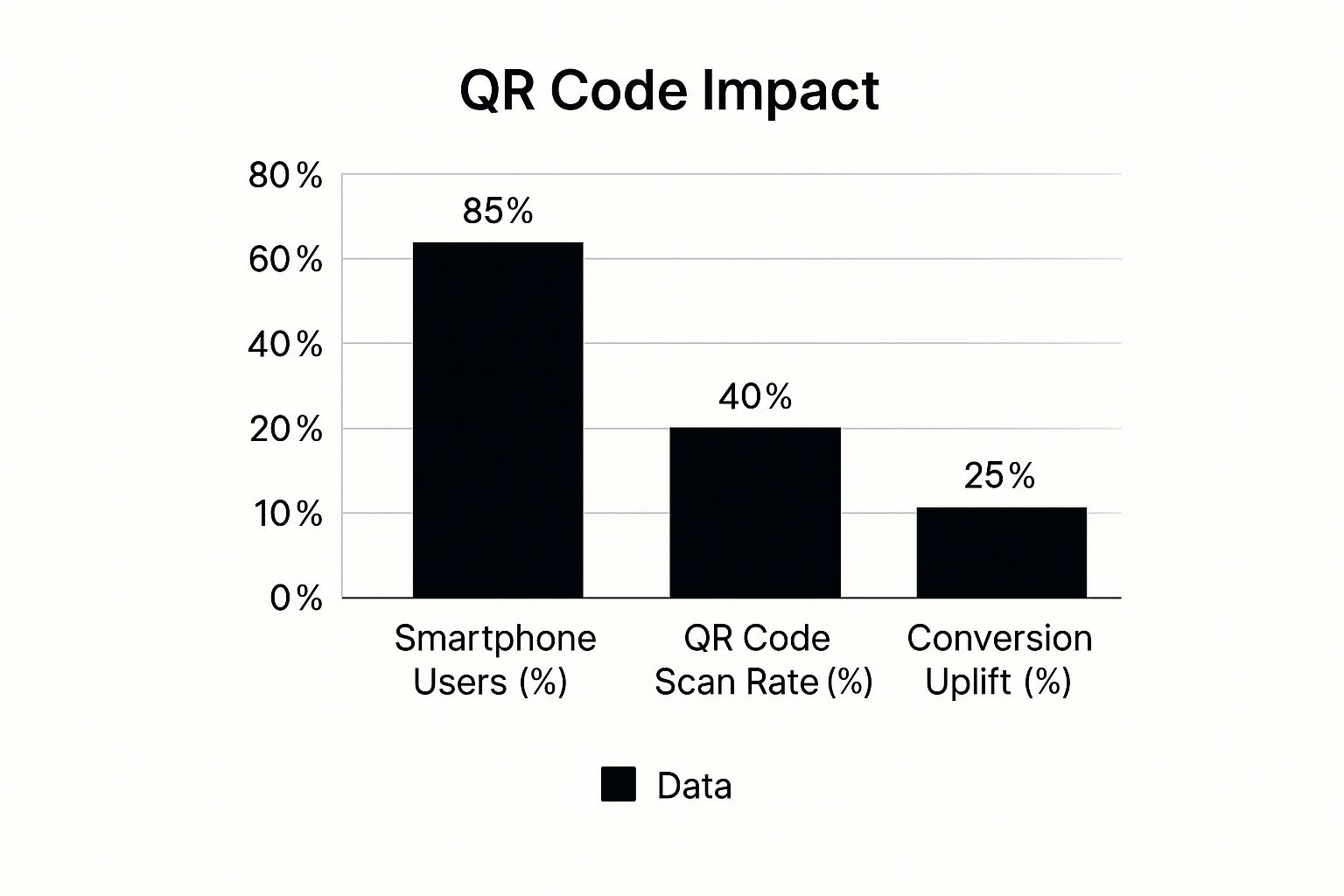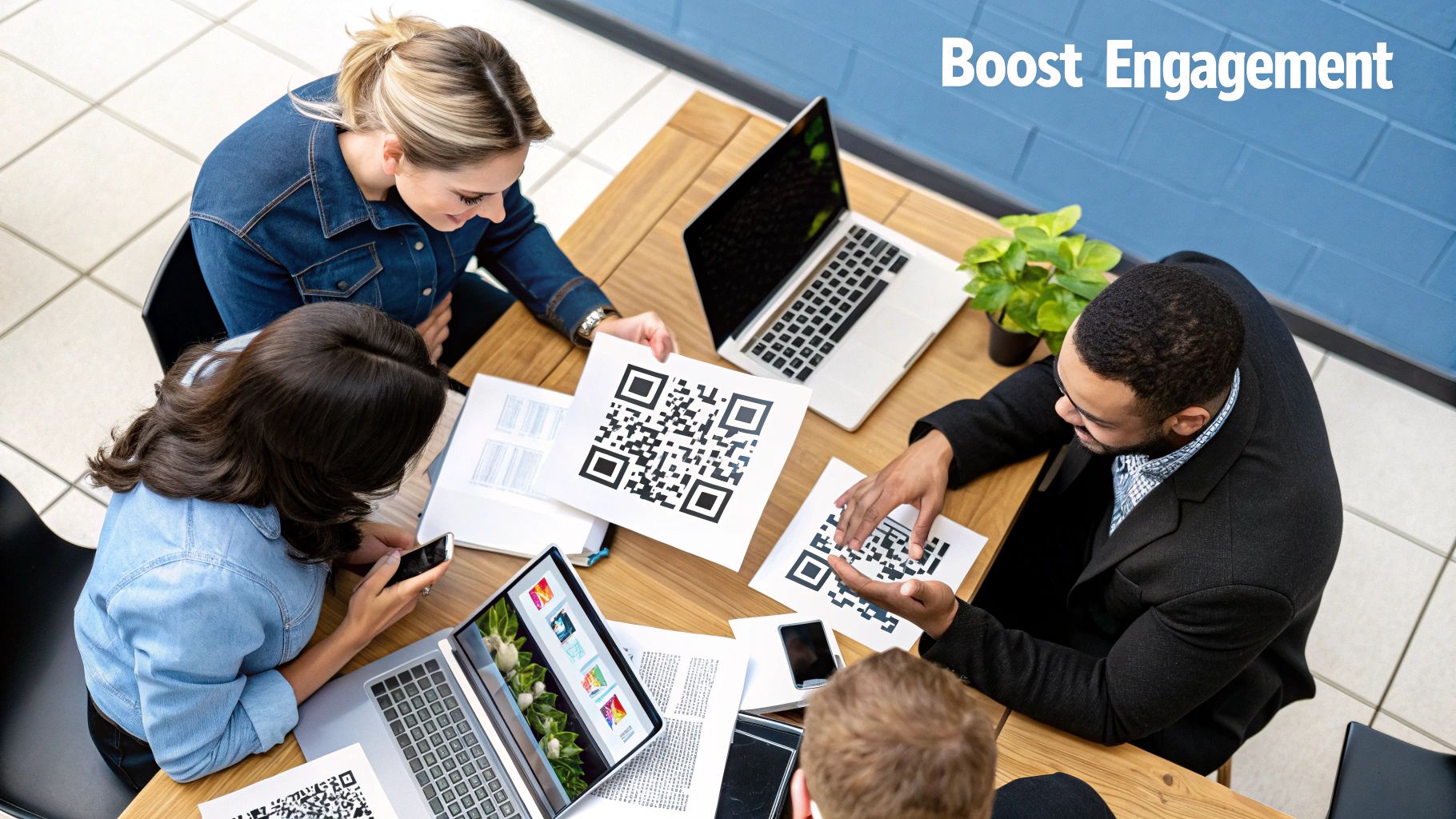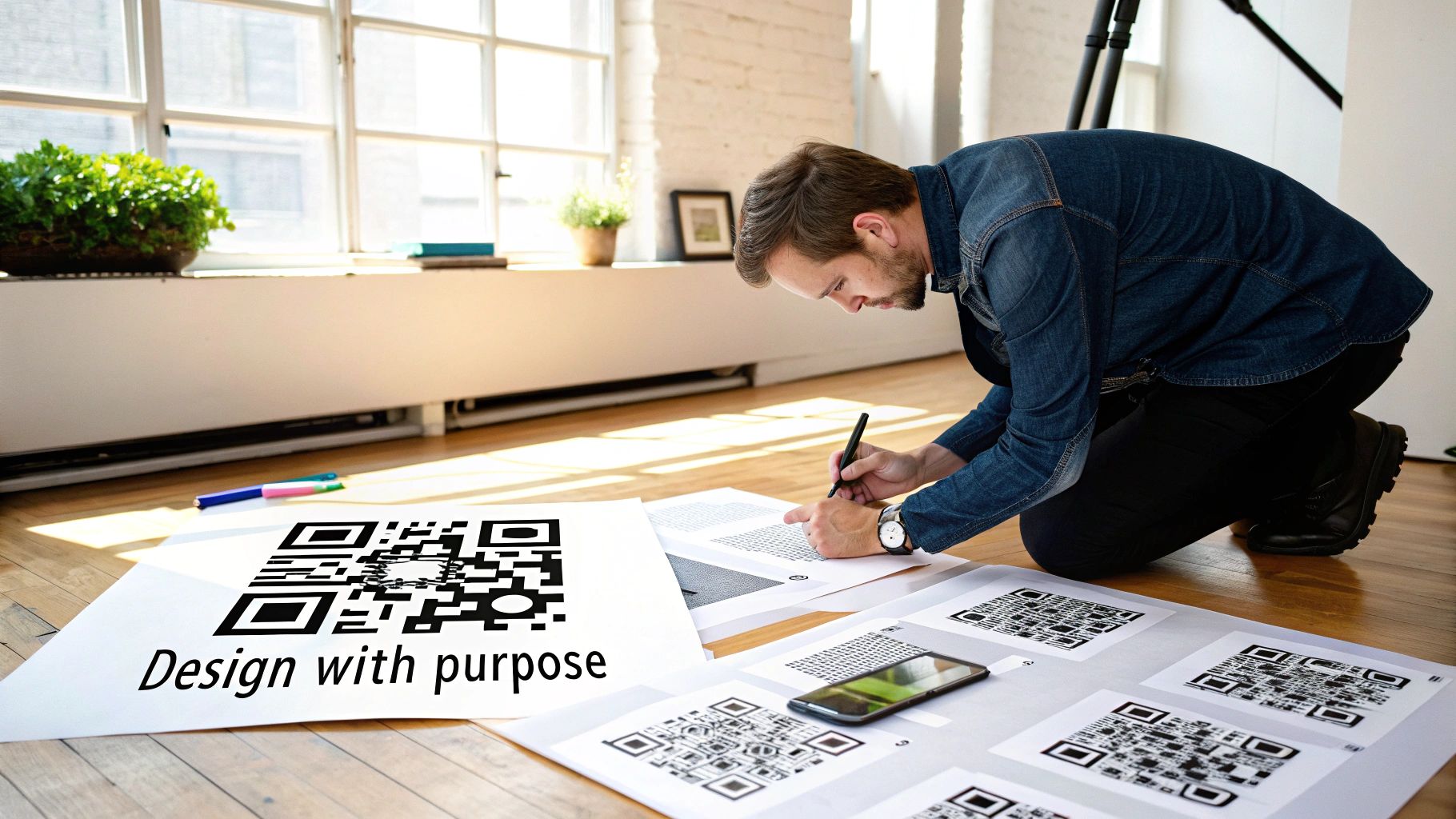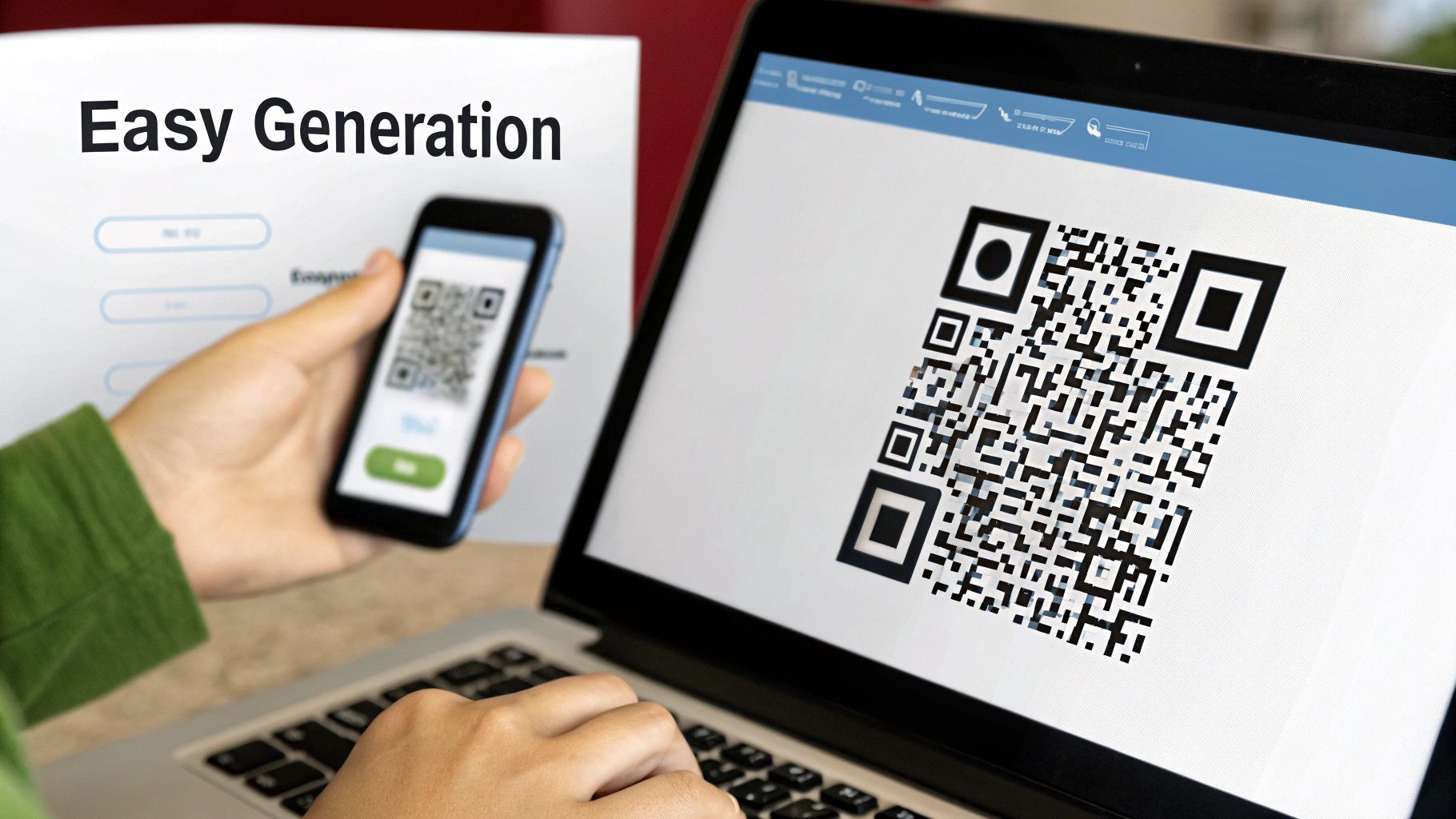Unlocking Your Call to Action QR Code Strategy
July 9, 2025
A call-to-action QR code is a scannable image that does more than just share information. It’s designed to get someone to do something specific right away, bridging the gap between looking at something physical and taking an action online. Instead of just showing a link, it includes a clear instruction—like "Scan for 20% Off" or "Watch the Demo"—that turns a passive glance into a real, measurable interaction.
From Passive Glance to Immediate Action
Imagine turning a casual look at a poster, a menu, or your product’s packaging into a direct line to your customer. That's exactly what a well-crafted call-to-action QR code does. Think of it less as a bit of tech and more as a digital shortcut, wiping out the small bit of effort that often stops a potential customer from taking the next step. Why make someone type out a long website address when they can just point their phone and scan?
This simple act of removing friction is what makes these codes so incredibly effective. They tap directly into our modern need for instant results. Whether your goal is to get more website traffic, capture new leads, or boost sales, a strong QR code with a clear call-to-action makes the next step completely effortless. It's this smooth transition from fleeting interest to a concrete result that really matters.
The Power of the Prompt
The words you put next to your QR code are just as crucial as the code itself. Vague instructions like "Scan Here" are easy for people to ignore because they don't answer the silent question everyone has: "What's in it for me?"
The best calls to action are specific, highlight a benefit, and create a sense of immediate value. They give people a compelling reason to pull out their phones.
Just look at the difference:
- Weak CTA: "Learn More"
-
Strong CTA: "Scan to Get a Free Quote"
-
Weak CTA: "Our Website"
- Strong CTA: "Scan to See Our Menu"
The stronger versions work because they set clear expectations and promise a real, immediate reward for the simple act of scanning.
A QR code without a clear call to action is like a door without a handle—people see it, but they have no idea how to open it or what's on the other side. The CTA is the handle that invites them in.
This chart shows just how perfectly QR codes fit into our current world, linking the massive number of smartphones in use to scan rates and their direct impact on conversions.

The data makes it obvious: with so many people carrying smartphones, a huge chunk of them are actively scanning QR codes, which leads to a real, measurable jump in conversions. The growth is undeniable, with projections showing global scans will hit 41.77 million in 2025—that's a 433% increase in just four years. This boom is fueled by the nearly 4.5 billion smartphone users worldwide, making the call-to-action QR code a non-negotiable tool for any modern marketer. You can dive deeper into the stats on the global adoption of QR codes on qrcode-tiger.com.
Choosing the right words for your QR code prompt is key. You want to match the text to the action you want the user to take.
Here’s a quick-reference table to help you pick the perfect CTA for your goal.
Effective QR Code Calls to Action
| Your Goal | Effective CTA Phrase | Digital Action Triggered |
|---|---|---|
| Drive Sales | Scan for 20% Off | Opens a product or checkout page with a discount. |
| Generate Leads | Scan to Get a Free Quote | Opens a contact or lead-capture form. |
| Increase App Downloads | Scan to Download Our App | Opens the App Store or Google Play Store page. |
| Share Information | Scan to See Our Menu | Opens a web page or PDF file with the menu. |
| Gather Feedback | Scan to Leave a Review | Opens a Google, Yelp, or other review platform page. |
| Boost Social Media | Scan to Follow Us | Opens your brand’s social media profile (e.g., Instagram, Facebook). |
Using specific, action-oriented phrases like these tells people exactly what to expect and gives them a good reason to scan. This simple clarity can make all the difference.
Why QR Codes Connect So Effectively with Customers

The real magic of a call to action QR code is how simple and direct it is. It taps right into the modern consumer’s need for immediate results with almost zero effort. Think of it as a tool that dramatically lowers cognitive load—the mental gymnastics required to get something done.
Instead of asking a customer to remember a website, pull out their phone, open a browser, and peck out a URL, you just give them a pattern to scan. This tiny shift removes just enough friction to make a massive difference in whether they'll actually do it. It’s often the deciding factor between someone noticing your ad and actually engaging with it.
Bridging the Gap with Instant Gratification
In a world where everyone is short on time and attention, a QR code delivers a dose of instant gratification. A quick scan provides an immediate reward, whether that's a discount, a behind-the-scenes video, or some exclusive content. This seamless path from physical curiosity to a digital payoff is incredibly satisfying.
It’s this experience that turns a passive observer into an active participant. For example, a "Scan to See How It's Made" QR code on your packaging doesn't just offer information; it deepens the customer's bond with your brand. Each scan reinforces that you’re helpful, transparent, and easy to do business with.
A QR code is more than just a link. It's a promise of a quick, valuable, and effortless experience. It respects the user's time by making the journey from interest to action as short as possible.
Gathering Insights in a Cookieless World
Beyond making things easy for customers, QR codes have become a crucial tool for gathering first-party data. As the digital world moves on from third-party cookies, marketers are looking for better ways to understand their audience, and a call-to-action QR code provides a direct line to people who are already engaged.
Every single scan is a clean signal of interest. It gives you transparent, actionable data on your campaign’s performance. You can see which physical locations, products, or flyers are driving the most traffic. This kind of information is priceless for fine-tuning your strategy without resorting to invasive tracking. Our guide on using QR codes in advertisements digs deeper into how to get the most out of this.
What started as a novelty is now a firm consumer habit. Fresh data shows that by 2025, 59% of consumers scan QR codes daily, and these scans are hitting an impressive average click-through rate of 37%. Better yet, 95% of businesses say QR codes help them get transparent insights, and 79% are now using dynamic codes to build personalized customer journeys. You can learn more about QR code engagement trends on uniqode.com to see the full findings.
Crafting a Call to Action That People Actually Scan

Let’s be honest: a QR code without a clear instruction is just a fancy black-and-white square taking up space. To turn that passive pattern into something people actually use, you need a solid call to action. It has to give them an undeniable reason to pull out their phone and scan.
The perfect call to action QR code answers a simple, unspoken question every person has: "What’s in it for me?"
Think of your CTA as the voice of your QR code. Vague phrases like "Scan Me" are easy to ignore because they offer zero value. You have to be specific and show the benefit. Strong action verbs are your best friends here. Instead of a passive request, lead with a verb that promises a real outcome.
A restaurant menu, for instance, could say "Scan to See Today's Specials" instead of just "Our Menu." That small change turns a boring piece of paper into a timely, dynamic offer. The instruction feels immediate and relevant, making the scan an easy decision.
The Anatomy of a Powerful QR Code CTA
A great CTA follows a simple but effective formula. It combines a clear action with an obvious reward, so the benefit of scanning is crystal clear. Your message has to be short and to the point—you only have a split second to grab someone’s attention.
Here’s how to frame your prompt for the best results:
* Start with a strong action verb. Words like "Get," "Unlock," "Reveal," or "Join" are far more interesting than "Click" or "Learn."
* Clearly state the benefit. What will they get? A discount? Exclusive content? A free guide? Be explicit.
* Create a sense of urgency or exclusivity. Phrases like "Scan to Win," "Get Your Coupon Now," or "Join the VIP List" make the offer feel special and time-sensitive.
The best CTAs don't just tell people what to do; they show them why it's worth their time. They connect the simple act of scanning to an immediate, personal benefit.
To make this practical, let's look at a few good vs. bad examples. Notice how the stronger options are specific and focus on what the user gets in return.
- Weak: Scan for Info
-
Strong: Scan for Full Product Specs
-
Weak: Our Website
- Strong: Scan to Take a 360° Virtual Tour
Context is also everything. A CTA on a trade show banner ("Scan to Win a Free Demo") should build excitement, while one on product packaging ("Scan for Assembly Instructions") needs to offer practical help. By matching your message to the user's immediate needs and their environment, you make your call to action QR code an irresistible next step.
Strategic Placement for Maximum Engagement
You’ve spent time crafting the perfect message for your call to action QR code, which is a huge step. But the job isn't quite done. Where you put that code is just as critical as the words you use to sell it.
Think of it like telling a great joke—the timing and setting are everything. A brilliant punchline told at the wrong moment just falls flat. The same is true for your QR code. Its location determines whether it gets seen, scanned, and acted upon.
The trick is to place your QR code where your audience is already hanging out and has a moment to spare. You want the scan to feel like a natural, helpful next step, not a chore. The environment itself provides the context, making the action you're asking for feel much more relevant.
For example, a "Scan to View Today's Specials" code on a restaurant table just makes sense. Diners are already seated, curious about the menu, and have their phones out. But if you slapped that same code on a highway billboard, it would be useless. No one can safely scan it while driving.
Matching Your Code to Its Environment
Great placement is all about context. The best spot for your QR code aligns with your audience's mindset and what they're doing right at that moment.
A furniture store could put a "See It In Your Room" QR code in its print catalog. This lets a customer use augmented reality to instantly visualize a new sofa in their own living room, bridging the gap between browsing a page and feeling confident enough to buy.
Here are a few other high-impact placements to get you thinking:
- Product Packaging: A code on the box can offer "Assembly Instructions," "Care Tips," or "Exclusive Recipes." This adds value long after the sale and helps build a loyal customer base.
- In-Store Displays: Putting a code next to a product with a CTA like "Watch a Demo" or "Read Customer Reviews" can give a shopper that final nudge they need to make a decision.
- Event Banners and Posters: At a conference, a "Download the Speaker's Slides" or "Join Our Networking Group" QR code gives attendees immediate access to resources they actually want.
- Direct Mail and Flyers: A code on a postcard with "Scan to Claim Your Exclusive Offer" is a fantastic way to drive measurable traffic from a physical mailer straight to your website.
The most successful QR code placements meet customers right where they are, offering a valuable digital shortcut at the exact moment their curiosity is highest. The goal is to make scanning feel like an intuitive and rewarding part of their experience.
The Modern Marketing Ecosystem
The call to action QR code has become so versatile that it's now a core part of modern marketing. It's not just a trend; recent data shows 93% of marketers ramped up their use of QR codes in the past year.
They’re weaving them into everything: email (47%), product packaging (46%), events (43%), and in-store displays (40%). This creates a seamless journey that connects the physical and digital worlds. And what gets people to scan? The promise of a reward, with discounts (33%) and exclusive content (39%) leading the pack as the most powerful incentives. You can discover more insights about these marketing trends from Bitly.
By placing these codes strategically, you’re not just hoping for scans—you’re building an interactive ecosystem. Whether it's a restaurant using RecodeQR to link tables to a dynamic menu or a brand turning its catalog into an AR experience, the right placement turns a static object into a powerful gateway for action.
Designing QR Codes That Get Noticed and Scanned

Let’s be honest, a standard black-and-white QR code can be a real eyesore. It easily blends into the background, becoming practically invisible to your customers. If you want your call to action QR code to actually work, its design needs to be just as thoughtful as the message behind it. A good-looking code doesn't just grab attention; it builds trust and subtly reinforces your brand.
Think of your QR code's design like a uniform. A generic code is like an employee in a plain t-shirt—easy to ignore. But a custom-branded code? That's your employee in a sharp, branded polo. It looks professional, trustworthy, and instantly recognizable as part of your team. That small distinction makes a huge difference in getting that all-important scan.
Balancing Brand and Scannability
Adding your brand’s logo and colors is a great way to make your code pop. But you have to be careful. Go too far with the creative flair, and you might accidentally make the code impossible to scan. The real trick is finding that sweet spot between aesthetics and function.
A popular and effective move is to pop your logo right in the middle of the QR code. Most QR code generators, including RecodeQR, use error correction that allows up to 30% of the code to be covered up without messing up the scan. This gives you a perfect little space for your logo.
When it comes to color, the single most important rule is to maintain high contrast. A light yellow code on a white background, for example, is a recipe for failure. Stick with dark patterns on light backgrounds, and you'll be in good shape.
Critical Design Rules for Success
Beyond logos and colors, a few technical details are non-negotiable if you want a reliable call to action QR code. Getting these right ensures your code works every single time, no matter where it is.
- Preserve the Quiet Zone: This is just the blank margin around the QR code. It's essential because it helps phone cameras separate the code from everything else around it. Don't let any text or graphics creep into this space.
- Use High-Resolution Formats: If you’re printing your code, always download it as a vector file (SVG or EPS). Vector files can be stretched to any size without getting blurry or losing quality. A fuzzy QR code is an unscannable QR code.
- Test, Test, and Test Again: Before you hit "print" on a thousand flyers, test the code. Use a few different phones and scanner apps to make absolutely sure it works perfectly.
A well-designed QR code does more than just link to a website; it acts as a visual handshake, assuring users that the digital experience ahead is professional, secure, and worth their time.
To really master the look and feel, our complete guide on QR code branding dives into more advanced tips and examples. Following these design principles will help you create a code that not only works flawlessly but also strengthens your brand and convinces people to pull out their phones.
Common Questions About Call to Action QR Codes
Even with a great plan, a few questions always come up when you’re trying something new. On the surface, a call to action QR code seems straightforward, but getting a few key details right can be the difference between a campaign that flops and one that succeeds.
Nailing these details helps you sidestep common mistakes and squeeze the most value out of every single scan. Let's walk through some of the questions I hear most often.
What Is the Difference Between a Static and a Dynamic QR Code?
Think of a static QR code like a sentence printed on a piece of paper—once it’s printed, it’s permanent. The destination, like a website URL, is baked directly into the code’s black-and-white pattern. If you make a typo or need to change the link, you’re out of luck. You have to create and print a brand-new QR code.
A dynamic QR code, however, is more like a smart shortcut on your computer. The code itself doesn't contain the final destination. Instead, it points to a short, flexible redirect link that you control. This means you can change where that link sends people whenever you want, without ever touching the printed QR code.
For any real marketing campaign, dynamic codes are the only way to go. They're editable, trackable, and give you the freedom to adapt your strategy on the fly, saving you from expensive and wasteful reprints.
This flexibility makes a dynamic call to action QR code a must-have for everything from event posters to product packaging, where your offers and information might need updating down the road.
How Can I Track the Performance of My QR Code?
This is where dynamic QR codes really pull ahead. You can't improve what you can't measure, and performance tracking is built right into platforms like RecodeQR.
When you create a dynamic code, you get access to an analytics dashboard. This is your command center for understanding how people are interacting with your code. Key metrics usually include:
- Total Scans: The raw number of times your code has been scanned.
- Unique Users: How many different people scanned the code.
- Scan Location: See the city and country where your scans are happening.
- Device Type: A simple breakdown of iOS vs. Android devices.
If you want to go even deeper, you can add UTM parameters to your destination URL. These are just small tags you add to your link that feed data straight into tools like Google Analytics. This lets you see exactly what users who scanned your QR code do once they land on your website, like whether they fill out a form or make a purchase. To really level up, you should explore all the features of a trackable QR code and see how they can shape your next move.
What Are Some Common Mistakes to Avoid?
A few common, and totally avoidable, mistakes can stop your call to action QR code dead in its tracks. The good news is that they’re all easy to fix with a little forethought.
The single biggest mistake is forgetting to include a clear call to action. People won’t scan a random code if they have no idea what it does. Always put a short, action-focused instruction right next to it, like "Scan to Get 20% Off" or "Watch the Video."
Another huge fumble is linking to a webpage that isn't mobile-friendly. The entire QR code journey happens on a smartphone. If you send them to a clunky desktop site that requires pinching and zooming, they’ll be gone in a flash.
Finally, keep an eye out for these technical slip-ups:
- Printing the code too small: It has to be big enough for a phone’s camera to see it clearly. A good rule of thumb is to make it at least 1x1 inch (2.5x2.5 cm).
- Poor color contrast: A light gray code on a white background is a recipe for frustration. Always stick with a dark code on a light, uncluttered background.
- No "quiet zone": The code needs a bit of empty margin around it to be read properly. Don't crowd it with other text or graphics.
Avoiding these simple blunders will make sure your QR codes are not just scannable, but actually effective at turning real-world curiosity into digital action.
Ready to create QR codes that get results? With RecodeQR, you can design, manage, and track dynamic QR codes with ease. Start your free trial today and see how simple it is to connect your physical marketing to the digital world. Get started with RecodeQR.
Ready to create your QR code?
RecodeQR is the easiest way to create QR codes you can track and edit anytime.
Free 3-day trial. No credit card required.